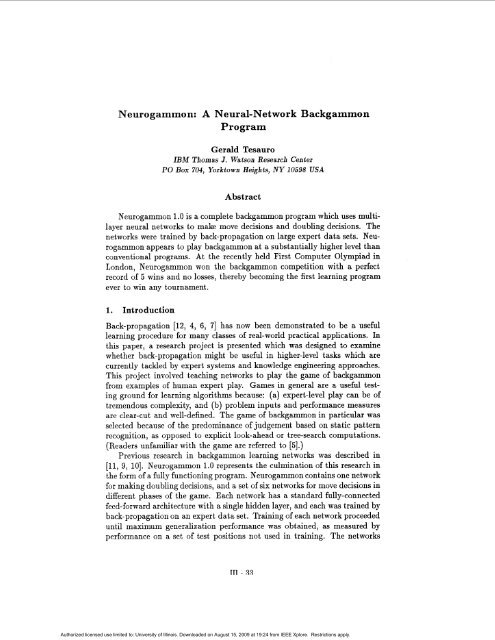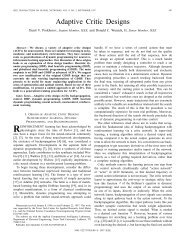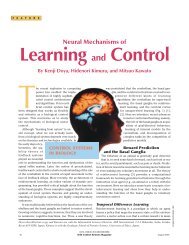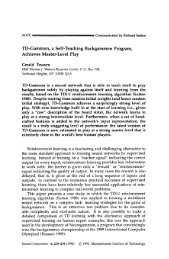Neurogammon: a neural-network backgammon program - Neural ...
Neurogammon: a neural-network backgammon program - Neural ...
Neurogammon: a neural-network backgammon program - Neural ...
- No tags were found...
Create successful ePaper yourself
Turn your PDF publications into a flip-book with our unique Google optimized e-Paper software.
<strong>Neurogammon</strong>: A <strong>Neural</strong>-Network BackgammonProgramGerald TesauroIBM Thomas J. Watson Research CenterPO Box 704, Yorktown Heights, NY 10598 USAAbstract<strong>Neurogammon</strong> 1.0 is a complete <strong>backgammon</strong> <strong>program</strong> which uses multilayer<strong>neural</strong> <strong>network</strong>s to make move decisions and doubling decisions. The<strong>network</strong>s were trained by back-propagation on large expert data sets. <strong>Neurogammon</strong>appears to play <strong>backgammon</strong> at a substantially higher level thanconventional <strong>program</strong>s. At the recently held First Computer Olympiad inLondon, <strong>Neurogammon</strong> won the <strong>backgammon</strong> competition with a perfectrecord of 5 wins and no losses, thereby becoming the first learning <strong>program</strong>ever to win any tournament.1. IntroductionBack-propagation [12, 4, 6, 71 has now been demonstrated to be a usefullearning procedure for many classes of real-world practical applications. Inthis paper, a research project is presented which was designed to examinewhether back-propagation might be useful in higher-level tasks which arecurrently tackled by expert systems and knowledge engineering approaches.This project involved teaching <strong>network</strong>s to play the game of <strong>backgammon</strong>from examples of human expert play. Games in general are a useful testingground for learning algorithms because: (a) expert-level play can be oftremendous complexity, and (b) problem inputs and performance measuresare clear-cut and well-defined. The game of <strong>backgammon</strong> in particular wasselected because of the predominance of judgement based on static patternrecognition, as opposed to explicit look-ahead or tree-search computations.(Readers unfamiliar with the game are referred to [5].)Previous research in <strong>backgammon</strong> learning <strong>network</strong>s was described in[ll, 9, 101. <strong>Neurogammon</strong> 1.0 represents the culmination of this research inthe form of a fully functioning <strong>program</strong>. <strong>Neurogammon</strong> contains one <strong>network</strong>for making doubling decisions, and a set of six <strong>network</strong>s for move decisions indifferent phases of the game. Each <strong>network</strong> has a standard fully-connectedfeed-forward architecture with a single hidden layer, and each was trained byback-propagation on an expert da.ta set. Training of each <strong>network</strong> proceededuntil maximum generalization performance was obtained, as measured byperformance on a set of test positions not used in training. The <strong>network</strong>sAuthorized licensed use limited to: University of Illinois. Downloaded on August 15, 2009 at 19:24 from IEEE Xplore. Restrictions apply.
appear to have learned a great deal of expert <strong>backgammon</strong> knowledge, andthe resulting <strong>program</strong> plays at a substantially higher level than conventional<strong>backgammon</strong> <strong>program</strong>s, as demonstrated by its decisive 5-0 win at the FirstComputer Olympiad.In the following, we examine in detail some of the key ingredients thatwent into the development of <strong>Neurogammon</strong>. In section 2, a “comparisonparadigm” for learning expert preferences is introduced, in which the <strong>network</strong>is told that the move preferred by the expert in a given situation should scorehigher than each of the other legal moves not selected by the expert. Thecomparison training paradigm was probably the most crucial ingredient inthe achievement of <strong>Neurogammon</strong>’s performance level, and in its victory atthe Computer Olympiad.Section 3 describes a separate <strong>network</strong> used to make doubling decisions,which was trained on a separate data base. Each position in the data basewas ranked according to a crude nine-point scale of doubling strength inmoney games. Doubling decisions were made by comparing a win probabilityestimate, based on <strong>network</strong> judgement and on racing considerations, with atheoretically optimal doubling point depending on the match score. Thewhole approach to doubling can only described as a quick and dirty “hack”done in a limited time before the Computer Olympiad, yet the consensus ofexpert opinion at the Olympiad was that <strong>Neurogammon</strong>’s doubling algorithmwas probably the strongest part of the <strong>program</strong>. Thus this was an instancewhere supervised learning lived up to the (sometimes naive) expectation thatit can be used to quickly develop a high-performance system with little efforton the part of the human <strong>program</strong>mer.In section 4, we examine <strong>Neurogammon</strong>’s performance at the ComputerOlympiad. The concluding section discusses the significance of the work, andsome future directions likely to yield further progress.2.Comparison training of expert move preferencesIn [ll], <strong>network</strong>s were trained to score single moves in isolation, based onexamples of human expert scores of moves. The input was a description ofan initial board position and a transition to a final position, and the desiredoutput was an expert’s judgement of the quality of the transition from initialto final position. The expert judgement recorded in the training data rangedfrom $100 for the best possible move to -100 for the worst possible movein a given situation. This approach is hereafter referred to as the “relativescore” paradigm (RSP).The RSP approach gave surprisingly good average performance, but sufferedfrom a number of fundamental limitations. The training data itself isproblematic, due to the arbitrary normalization, incompleteness (the humanexpert cannot comment on every possible legal move), difficulty of scoringbad moves (necessary for the <strong>network</strong>, but unusual for the human expert),and possible human errors. Furthermore, in this scheme, a sophisticatedscheme for coding the transition from initial to final board positions wasI11 - 34Authorized licensed use limited to: University of Illinois. Downloaded on August 15, 2009 at 19:24 from IEEE Xplore. Restrictions apply.
Type of RSPnet CP nettest set (651- 12- 1) (289-12- 1)bearoff .82 .83bearin .49 .63opp. bearoff .56 .59opp. bearin .49 .61other .55 .69Table 1: Performance of nets of indicated sizes trained in the relativescore paradigm (RSP) and in the comparison paradigm (CP) on respectivetest sets, as measured by fraction of positions for which netagrees with human expert choice of best move.required, using human expert concepts such as “slotting” and “stripping”points. More fundamentally, however, in the RSP approach, the <strong>network</strong>does not learn an intrinsic understanding of the position itself, but insteadonly learns what kinds of transitions between positions are desirable. Furthermore,the <strong>network</strong> can only judge one move at a time in isolation, withoutany knowledge of what other alternative are available. The latter problemis the most serious, since from the human expert point of view, the “goodness”or “badness” of a given move often depends on what other moves areavailable.In [lo], an alternative training paradigm called the “comparison paradigm”(CP) was reported. In this paradigm, the input to the <strong>network</strong> is two of theset of possible final board states, and the desired output represents the humanexpert’s judgement as to which of these two states is better. This curesthe most fundamental problem of the RSP method, as the <strong>network</strong> alwayslearns to judge a particular move in the context of the other moves thatare available. The comparison paradigm also has a number of other advantages.There are no problems due to the expert entering an incorrect score,no problems due to arbitrary score normalization, and no problems with uncommentedmoves. Also, one can present only final board positions and thusdoes not need a sophisticated scheme to encode the transitions from initialto final positions. Finally, it was shown in [lo] that symmetry and transitivityof comparisons can be exactly enforced by a constrained architecturein which the left half of the <strong>network</strong> only looks at board position a, and theright half only looks at board position b. The constrained architecture forceseach half-<strong>network</strong> to implement a real-valued absolute evaluation functionof a single final board position. The <strong>network</strong> thus does develop an intrinsicunderstanding of the position in this training methodology.Test-set performance of RSP nets and CP nets are compared in table 1.(The nets were trained according to the methodology of [lo].) The CP netshave a much smaller and simpler input coding scheme, and have significantlyfewer connections. The CP nets also have much stronger game performance.In particular, worst-case performance is dramatically improved by comparisontraining.I11 - 35Authorized licensed use limited to: University of Illinois. Downloaded on August 15, 2009 at 19:24 from IEEE Xplore. Restrictions apply.
3. <strong>Neurogammon</strong>’s doubling algorithm<strong>Neurogammon</strong> 1.0 has a separate <strong>network</strong> for making doubling decisionswhich was trained on a separate data set. The doubling data set containedabout 3000 positions taken from 64 expert games described in [3]. Each positionwas classified according to a crude nine-point ranking scale of doublingstrength, guided by the commentary in [3]. Of these positions, 225 were setaside at random to be used as test data; the remaining positions were usedas training data.The <strong>network</strong>s trained on this data set had 9 output units correspondingto the 9 possible categories. The input representation used a total of 243input units. This representation scheme was a simplification of the 289 unitscheme for the move selection <strong>network</strong>s.Interpreting the <strong>network</strong>’s output and measuring its performance on testdata after training is a somewhat subtle matter. It was decided for simplicityto just sum up all nine output values, and interpret that as the <strong>network</strong>’sscore for a particular position. An error measure can then be based on thedifference (T between this score and the recorded teacher score. If (T < 0.5, itindicates that the <strong>network</strong> has scored the position essentially correctly, while(T > 1.5 indicates a significant deviation from the correct answer. The bestperformance according this measure was obta.ined with a 243-24-9 <strong>network</strong>,which scored 61% of the test positions within 0.5 of the correct answer, andonly 6% off by more than 1.5 from the correct answer.In order to make optimal doubling decisions according to established theory[2, 131, one needs an estimate at any point during the game of the probabilityof each side winning the game. This was done in an admittedly crudeway by dividing the total <strong>network</strong> score by 10; this gives a number p, whichmay be interpreted as the <strong>network</strong>’s estimate of White’s probability of winningthe game. One can also compute by standard techniques [l, 2, 131 ahighly accurate estimate of the win probability based solely on the state ofthe race; this gives another estimate of win probability p,. <strong>Neurogammon</strong>1.0 makes doubling decisions by comparing an interpolated probability p, lyingbetween pn and p,, with the theoretical optimal doubling point po. Theinterpolation depends on the degree of contact, varying from p = p, for fullyengaged positions to p = p, for fully disengaged positions. This interpolationscheme is ad hoc, but it does have the effect of reducing or eliminating the<strong>network</strong>’s most serious and most frequent errors.4.Results of the Computer OlympiadThe First Computer Olympiad, which took place Aug. 9-15, 1989, at thePark Lane Hotel in London, was a unique event in the history of computergames. Organized by computer chess expert David Levy, the Olympiad featuredcompetitions in 15 different games, open to any computer <strong>program</strong>. Insome of these games, such as chess, Go, and Othello, computer competitionshave been held regularly for maay years, but for several other games such asI11 - 36Authorized licensed use limited to: University of Illinois. Downloaded on August 15, 2009 at 19:24 from IEEE Xplore. Restrictions apply.
oth machine learning and computer games research. For machine learningresearchers (and for <strong>neural</strong> <strong>network</strong>s researchers in particular), it provides aconvincing practical demonstration that <strong>network</strong> learning algorithms can beuseful in tackling hard computational tasks. It should be emphasized thattournament performance is a severe test of the <strong>network</strong>s’ ability to extractgood generalizations from the training data, rather than merely memorizespecific individual positions. Apart from the first couple of moves at thestart of each game, it is highly unlikely that any of the positions encounteredby <strong>Neurogammon</strong> at the Computer Olympiad were contained in the trainingset.The significance to computer games research is that it is apparently thefirst time in the history of computer games research that a learning <strong>program</strong>has ever won an official tournament in an established game of skill. Machinelearning procedures have been studied in computer games environments formany years, but learning <strong>program</strong>s typically have not achieved the levels ofperformance necessary to win in tournament competition. <strong>Neurogammon</strong>’sachievement suggests that learning procedures may be more widely useful inother complex games such as chess and Go.While <strong>Neurogammon</strong> can only be described as a strong <strong>program</strong>, it clearlyhas to improve in a number of ways before it can be claimed to perform athuman expert level. One obvious improvement would be to train on a largerand more varied expert data set containing data from several experts exhibitinga variety of styles of play. The move-selection <strong>network</strong>s in particularare dangerously inbred, having been trained only on data from one individual.Further significant improvement might be obtained by adding a smallamount of look-ahead, perhaps by going to a 3-ply search.Another way in which learning could be improved is by incorporatingspecial knowledge about symmetry or topology of the problem either intothe data representation scheme or the <strong>network</strong> architecture. For example,one knows that the evaluation function should have an exact symmetry inthat, if the configuration of the Black and White pieces are swapped, and theplayer to move is reversed, then the evaluation should exactly invert, i.e., thescore S + -S. Also, one knows that <strong>backgammon</strong> has a one-dimensionalspatial structure with approximate translation invariance. Explicitly buildingthese symmetry principles into the learning system could enable it to extractbetter generalizations from a limited amount of training data.Another direction which seems very promising is to abandon supervisedlearning altogether, and instead to learn by playing out a sequence of movesagainst an opponent and observing the outcome. Such a learning systemcould learn on its own, without the aid of an intelligent teacher, and inprinciple could continue to improve until it surpassed even the best humanexperts. Connectionist algorithms such as Sutton’s Temporal-Difference algorithm[8] could be used in such an approach. It is not known whether suchalgorithms are efficient enough to tackle a problem of the scale and complexityof <strong>backgammon</strong>. However, it seems most likely that they could be usedto learn a highly accurate end-game evaluation function. Since the late (butAuthorized licensed use limited to: University of Illinois. Downloaded on August 15, 2009 at 19:24 from IEEE Xplore. Restrictions apply.
ackgammon, it was the first organized tournament for computer <strong>program</strong>s.<strong>Neurogammon</strong> faced five opponents in the <strong>backgammon</strong> competition atthe Olympiad: three commercial <strong>program</strong>s (Video Gammon [USA], SaitekBackgammon [Netherlands], and Mephisto Backgammon [West Germany])and two non-commercial <strong>program</strong>s (Backbrain [Sweden] and AI Backgammon[USA]). Hans Berliner’s BKG <strong>program</strong> was not entered in the competition.All five <strong>program</strong>s apparently used single-ply search algorithms withconventional hand-crafted evaluation functions. In matches to 11 points,<strong>Neurogammon</strong> defeated Video Gammon by 12-7, Mephisto by 12-5, Saitekby 12-9, Backbrain by 11-4, and AI Backgammon by 16-1. With five matchvictories and no losses, <strong>Neurogammon</strong> convincingly won the gold medal for<strong>backgammon</strong> at the Computer Olympiad. <strong>Neurogammon</strong> also played fourunofficial matches to small numbers of points against intermediate-level humans,and won three out of the four matches. Finally, in an official challengematch on the last day of the Olympiad, <strong>Neurogammon</strong> put up a good fightbut lost to a human expert, Ossi Weiner of West Germany, by 2-7. Weinerwas clearly the better player, but the difference in skill levels was not as greatas suggested by the score. Weiner said that he was impressed by how muchthe <strong>program</strong> played like a human, how rarely it made mistakes, and that hehad to play extremely carefully in order to beat it.To summarize, there were two main ingredients behind <strong>Neurogammon</strong>’ssuccess at the Computer Olympiad. First, its doubling algorithm turned in avery solid performance: although its play was not technically perfect, it didnot make a single decision that would cause an expert to complain duringthe entire tournament. Second, in comparison to its opponents, its moveselection was very aggressive and much more in the style of a human expert.Several expert strategies and tactics used by <strong>Neurogammon</strong> (e.g., slotting,blitz attacks, and back games, to name some of the most prominent) appearedto be missing completely from the other <strong>program</strong>s.It was also interesting to observe the differences in the errors made by<strong>Neurogammon</strong> in comparison to those of its opponents. <strong>Neurogammon</strong>’serrors were mainly tactical in nature; its positional judgement was usuallyquite good. The other <strong>program</strong>s, however, usually made tactically acceptableplays (given their lack of knowledge of expert tactics), but often displayedbad positional judgement. This leads one to speculate that a facility to searchbeyond one ply would be more profitably added to <strong>Neurogammon</strong> than toa conventional <strong>program</strong>. A small amount of look-ahead can cure immediatetactical problems, but is unlikely to make a significant improvement in a<strong>program</strong> with fundamentally flawed positional judgement. Other possibleimprovements to <strong>Neurogammon</strong> are discussed below.5. Conclusions<strong>Neurogammon</strong> 1.0 demonstrates that a great deal of human expert knowledgein a complex domain can be learned by multilayer <strong>neural</strong> <strong>network</strong>s from largeexpert data sets. Its victory at the Computer Olympiad has significance forI11 - 37Authorized licensed use limited to: University of Illinois. Downloaded on August 15, 2009 at 19:24 from IEEE Xplore. Restrictions apply.
still engaged) stages of the game are precisely where <strong>Neurogammon</strong> currentlygoes most seriously wrong, learning from outcome could at least provide auseful supplement to what can be achieved with supervised learning, and atmost could be used to learn the entire game to better than human worldchampion level.References[l] H. Berliner, “Experiences in evaluation with BKG- a <strong>program</strong> that plays<strong>backgammon</strong>,” Proc. of UCAI, 428-433 (1977).[2] E. B. Keeler and J. Spencer, “Optimal doubling in <strong>backgammon</strong>.’’ OperationsResearch 23, 1063-1071 (1975).[3] B. Kennedy and C. Papazian, Backgammon Master Games. Palo Alto:Shima Publishing (1981).[4] Y. Le Cun, “A learning procedure for asymmetric <strong>network</strong>.” Proceedings ofCognitiva (Paris) 85, 599-604 (1985).[5] P. Magriel, Backgammon, Times Books, New York (1976).[6] D. B. Parker, “Learning-logic.” MIT Center for Computational Research inEconomics and Management Science Tech. Report TR-47 (1985).[7] D. E. Rumelhart, G. E. Hinton and R. J. Williams, “Learning representationsby back-propagating errors.” Nature 323, 533-536 (1986).[SI R. S. Sutton, “Learning to predict by the methods of temporal differences.”Machine Learning 3, 9-44 (1988).[9] G. Tesauro, “<strong>Neural</strong> <strong>network</strong> defeats creator in <strong>backgammon</strong> match.” Univ.of Illinois, Center for Complex Systems Technical Report CCSR-88-6 (1988).[lo] G. Tesauro, “Connectionist learning of expert preferences by comparisontraining.” In: D. Touretzky, ed., Advances in <strong>Neural</strong> Information Processing1, 99-106, Morgan Kaufman Publishers (1989).[ll] G. Tesauro and T. J. Sejnowski, “A parallel <strong>network</strong> that learns to play<strong>backgammon</strong>,” Artificial Intelligence 39, 357-390 (1989).[12] P. Werbos, Ph. D. Thesis, Harvard University (1974).[13] N. Zadeh and G. Kobliska, “On optimal doubling in <strong>backgammon</strong>.” ManagementScience 23, 853-858 (1977).I11 - 39Authorized licensed use limited to: University of Illinois. Downloaded on August 15, 2009 at 19:24 from IEEE Xplore. Restrictions apply.









